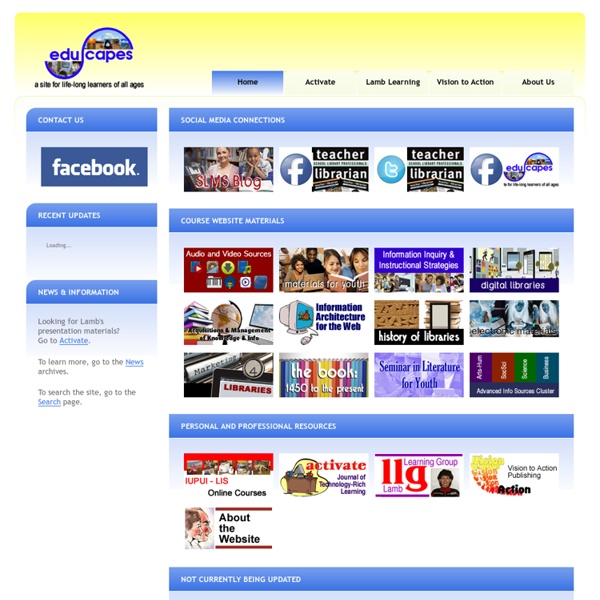



Marketing for Libraries What do people want and need from a library? What services can your library provide? How can services be connected with the needs of current and potential library users? Marketing is much more than creating attractive displays and updating your Facebook page, it's about meeting the needs of individuals and groups. Marketing is about understanding the needs and interests of current and potential users, reaching those individuals with quality resources and services, and evaluating the experience so adjustments can be made to increase effectiveness, efficiency, and appeal. Regardless of whether you're interested in academic, school, public, corporate, health, and/or other special library or information settings, this course is a great elective. Explore the Course Materials section to read the Syllabus, explore the Calendar, Tips and Checklist, or access the Course Guide.
Garbology Featured Activity: Waste-Less Lunch Lead your students in learning about natural resources used in common packaging materials. Challenge your students to conserve natural resources through their lunch choices. Check out this and other Garbology lessons for the classroom » Featured Activity: Conduct a Waste Assessment Do you know how much waste your school puts in landfills each week? Learn how and check out other Garbology activities » Featured Activity: Composting With the FBI The FBI turn waste into healthy soil. Bring Garbology home » Free Interactive Whiteboard Resources Interactive whiteboard resources are a great way for teachers to engage classrooms in learning. While many teachers are spending hours a day creating their own activities for their interactive whiteboards, there are tons of free sources to help teachers learn about and use IWBs with students to further their use of technology in the classroom. Here is a list of some great interactive whiteboard resources and activities guaranteed to stimulate learning: General Interactive Whiteboard Resources for Teachers TeacherLED – TeacherLED is a site dedicated to making the use of Interactive Whiteboards (IWB) easier and more productive. With many kids at home due to COVID-19, maintaining the same level of physical... The recent ongoing pandemic has schools reimagining how they celebrate their... With the school year coming to a close, providing closure for students is... Delivering quality education to students through eLearning can be difficult.... Interactive Whiteboard Games & Activities
10 Great Technology Initiatives for Your Library Today’s hottest web and mobile technologies are offering libraries a new world of opportunities to engage patrons. Ultra-popular social media websites and apps combined with the availability of affordable cloud-based services and the evolution and adoption of mobile devices are enabling librarians to share and build communities, store and analyze large collections of data, create digital collections, and access information and services in ways never thought about before. Libraries have become technology leaders by integrating cutting-edge tools to enhance users’ experience. Forward-thinking librarians are actively experimenting with and incorporating these new technologies into their digital strategies. Host a cloud-based collection As libraries increasingly deliver digital content, storage requirements may strain their local resources. For example, you could store content in Amazon S3 and use your library’s ILS to describe and present links to it. Create a basic mobile website
Wonderopolis | Where the Wonders of Learning Never Cease | Wonderopolis Interactive Video Learning Tell a Story This story’s unique quality is its focus on narration and digital storytelling. Learning how to tell a story, to eloquently convey a point or to convince an audience, for example parents or other adults, can be considered a general expert skill, relevant to all areas of interest. This learning story will convey storytelling as a meaningful learning experience and answers the question of how storytelling and narrative relate to all subject areas. Using digital storytelling may motivate students and allow for non-traditional tasks and activities. Storytelling design brief – Create an engaging short video story that relates a scientific phenomena to a personal experience and is no longer than 5 minutes. Select an audience and be sure to tell the story in an engaging, factually correct, yet understandable way for your audience. Adil Tugyan, a teacher in Rize, Turkey, uses 'Tell a Story' in his English class to teach pupils about the correct use of 'can/can't'.
Video Library | MIT BLOSSOMS Jump to Navigation Show Menu BLOSSOMS Video Library Mathematics Why Is the Natural Logarithm e Called “Natural”? Physics Hanging by a Thread Engineering Flow Charts: Logical Thinking? Biology The “Tenants” My Body Needs to Be Healthy The Science behind Music Successive Approximations as a Tool to Measure Distances How GPS Works Mathematics in Every Day Life The Science of Happiness: An Introduction to Positive Psychology Understanding Genetically Modified Organisms Give Me a Standard, and I Will Change the World What is Correlation, and How to Distinguish It from Causation Do You See a Ghost? Fun on the Sphere An Introduction to the Physics of Sailing Recognizing Forces: Does the Floor Know when You Put on Weight? Elasticity: Studying How Solids Change Shape and Size Chemistry Mole: Connecting the Micro to the Macro Temperature, Pressure and American Football: Introduction to Gay-Lussac's Gas Law The Biological Mysteries of Kimchi: Examining How Plants Absorb and Lose Water How Tall Is That? Fence Your Equation